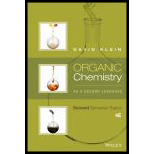
Interpretation:
The expected directing effects that would be observed if the given compound undergoes an electrophilic
Concept Introduction:
Electrophilic substitution reaction is a type of reaction in which a particular group or atom in a compound is replaced by electrophile. An electrophile is a species that is deficient of electrons
Deactivators are electron withdrawing groups attached to the benzenes that have either positive charge or an atom with high electronegativity. They are meta directors.
Activators are electron donating groups attached to the benzenes that have either electron density that is able to push into benzene ring or a lone pair of electrons. They are ortho-para directing.
Halogens are deactivators that are ortho-para directing.
Want to see the full answer?
Check out a sample textbook solution
Chapter 4 Solutions
Organic Chemistry As a Second Language: Second Semester Topics
- Determine which nucleophilic aromatic substitutions are likely, and proposemechanisms for both the addition–elimination type and the benzyne type.arrow_forwardWhich among the given compounds is being described by the following statements? Choose your answer from the BRIGHT WIN TINE Activates the ring towards electrophilic aromatic substitution and directs an electrophile to the para position: Deactivates the ring towards electrophilic aromatic substitution and directs an electrophile to the ortho position: Deactivates the ring towards electrophilic aromatic substitution and directs an electrophile to the meta position:arrow_forwardShow how acid derivatives hydrolyze to carboxylic acids under either acidic or basicconditions. Explain why some acid derivatives (amides, for example) require muchstronger conditions for hydrolysis than other derivatives.arrow_forward
- Draw the structure of the compound whose data is shown below. Upload your answer to receive full credit. C9H,NO3 There are 7 C-NMR signals. The compound is significantly deactivated toward electrophilic aromatic substitution. H-NMR: 12.7 ppm, s, 1H 10.3 ppm, s 1H 7.91 ppm, d, 2H 7.72 ppm, d, 2H 2.10 ppm, s 3Harrow_forwardDescribe how an electron withdrawing group on an aromatic ring affects the proton chemical shifts of the aromatic protons.arrow_forwardWhich benzene derivative would be the most reactive in an electrophilic aromatic substitution reaction? NO2arrow_forward
- Provide the steps to convert the following aldehyde to the given amine product.arrow_forwardShow how to synthesize each of the following compounds using only a single nucleophilic aromatic substitution reaction. (a) NO, (b) (c) NO2 O,N ноarrow_forwardDetermine whether each of the following compounds can function as a suitable electrophile in a nucleophilic aromatic substitution reaction. NO₂ Ef O-S-CH3 I NO₂ Br X NO₂arrow_forward
- Rank the following compounds in the order of increasing reactivity in electrophilic aromatic substitution reaction.arrow_forwardUse the information below to identify and explain the relationship between the basicity of the two nucleophiles and their nucleophilicitiesarrow_forwardA compound (C3H,NO) gives the following NMR data. In the box below please draw the structure of the compound. 'H-NMR: 2.06 ppm, s(3H); 7.01 ppm, t(1H); 7.30 ppm, m(2H); 7.59 ppm, d(2H); 9.90 ppm, s(1H) 13C-NMR: 168.14; 139.24; 128.511; 122.834; 118.90; 23.93 • You do not have to consider stereochemistry. You do not have to explicitly draw H atoms. Do not include lone pairs in your answer. They will not be considered in the grading.arrow_forward
 Organic ChemistryChemistryISBN:9781305580350Author:William H. Brown, Brent L. Iverson, Eric Anslyn, Christopher S. FootePublisher:Cengage Learning
Organic ChemistryChemistryISBN:9781305580350Author:William H. Brown, Brent L. Iverson, Eric Anslyn, Christopher S. FootePublisher:Cengage Learning Organic Chemistry: A Guided InquiryChemistryISBN:9780618974122Author:Andrei StraumanisPublisher:Cengage Learning
Organic Chemistry: A Guided InquiryChemistryISBN:9780618974122Author:Andrei StraumanisPublisher:Cengage Learning EBK A SMALL SCALE APPROACH TO ORGANIC LChemistryISBN:9781305446021Author:LampmanPublisher:CENGAGE LEARNING - CONSIGNMENT
EBK A SMALL SCALE APPROACH TO ORGANIC LChemistryISBN:9781305446021Author:LampmanPublisher:CENGAGE LEARNING - CONSIGNMENT


